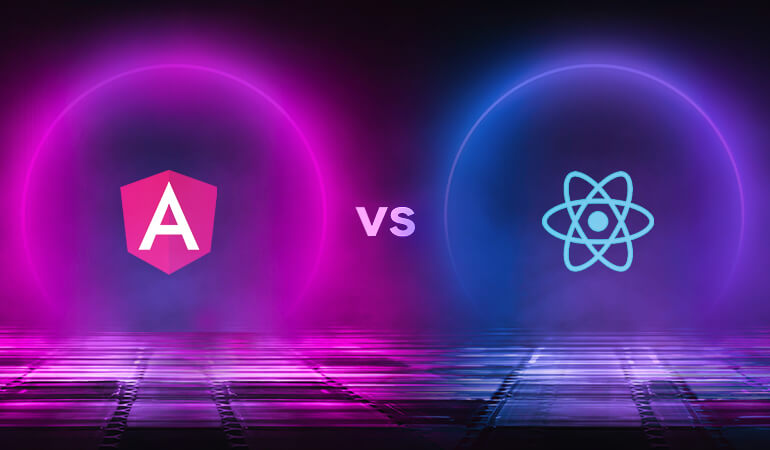
Web development has undergone massive changes and transformations lately. Among other things impacting the pace, introduction, and upgrades of various frameworks have had their share of impact on web development. React vs Angular are two pillars in web development. The word JavaScript Ecosystem immediately brings the thought of Angular vs React. However, these two are pretty famous front-end development frameworks of JavaScript.
But, the questions at hand are:
- Which approach to exercise between the two?
- What are the project requirements?
- How do we reach an accurate and informed decision?
- How do we ramp up the performance in the initial stages of web development using these approaches?
There has been an evident rivalry between Angular vs React. Even now, the developers still argue which one is the better option. To illustrate the difference and identify which framework to use, we must understand each term first.
How do we define Angular?
In 2010 Google developed the Angular framework, and it was called Angular JS. Google maintains the framework too.
Angular is a structured framework that operates on the principle of dynamic web apps. Developers use HTML for developing web pages. HTML syntax showcases the components of the application.
Angular is a dynamic development framework that has all the features of JavaScript. These dynamic features help developers with dynamic and single-page web applications. The angular framework also works best in the MVC programming structure.
Back in the day, this framework rose to fame quickly for being one of a kind. It had three noticeable capabilities that made it quite famous:
- Two-way data binding
- Dependency injections
- A giant tech company supported this framework
Angular 2.0 was later launched in September of 2016. It was a better, modified, and redesigned version of Angular JS (1.0).
Prominent features of Angular
Some of the notable features of angular are:
- It has built-in function support for AJAX, HTTP, and Observables
- Coordinated and consistent with the latest technology
- Efficient typescript enables time-saving
- It has 3 Cs of coding; clean, clear, and crisp
- Efficient and intelligent error-handling support
- Angular command life interface (CLI) supports seamless upgrades and updates
- Provides validations
- An array of forms for different aspects of web development
- It supports local CSS for components or shadow DOM
- A clear separation between UI and BL (business logic)
When should we go for Angular?
Angular is the apt framework under the following circumstances:
- Angular is your best friend if you are looking for ready-to-use solutions and wish to save time while maintaining high work productivity.
- When you are looking for a large scale, flexible, and rich features application
- If the development team has a history and working experience with Java, C#, or even Angular
- If you are comfortable with low to medium app complexity
Angular vs Vue: Which is the Better Front-end Framework?
How do we define React?
React is a JavaScript library. It was developed and used by Facebook in 2013 as an open-sourced framework. Developers can use it to create user interface components. It can also create interactive UI as well.
Additionally, it facilitates the coding process by making it easier to understand, design, and launch. React JavaScript incorporates a server-side framework for delivering a flexible and performance-centric solution.
React JavaScript framework gained immense popularity. The component-based architecture was another web & mobile app development framework that became famous because of React. Below are some of the benefits of component-based architecture:
- Modular and coherent components: These have high practical value and speed up web app development
- Mobile app development: They are used in mobile app development. Developers reuse the logical section of the mobile app by tweaking it a bit.
- Maintenance and improvement: Since the components are self-contained, they are relatively easy to maintain.
React JavaScript took the market by storm. It replaced most of the existing frameworks of that time for its functionality and ease of use. It overthrew Angular JavaScript, which was also popular.
Seeing this market trend and passion, Google set off to incorporate component-based architecture in the JavaScript framework and started calling it Angular 2.
Prominent features of React:
Some of the notable features of React are mentioned below:
- React is coherent and compatible with third-party libraries so that you can use third-party libraries
- A composable and simple framework
- Full-time Facebook backing and support
- Enables fast-paced, efficient, and enhanced user experience
- Efficient react JS components
- Fast development
- Saves time
- Stable coding with solid single-directional data binding
When should we go for React?
React JS framework works ideally under given situations:
- If you are looking for an app that has multiple events
- If you have a team of IT professionals and developers that excel in HTML, CSS, and JavaScript frameworks
- When you require a customized app solution
- React is ideal for you when you wish to create components in your app that you can easily share
Comparison Between Angular Vs React:
Angular and React JS both use component-based architecture. But it is equally important to know that they have many similarities too. We will, however, ponder on the differences. Let’s have a look at how these two differ from each other.
Purpose
Angular: It has a full-fledged framework. Firstly, the purpose of angular is to provide a strong opinion regarding your application needs and how it should be structured. The angular framework consists of small built-in libraries that make up an app’s complex infrastructure.
React: React Library focuses entirely on the MVC architecture. Moreover, React requires Flux to implement the View on MVC. It offers complete freedom to sort the code according to your need. It also, at times, requires additional libraries.
Data-binding
Angular: It has a two-way data binding feature. Data binding involves synchronizing data between model and view. It means changing the input in the user interface triggers changes in the model state and vice versa.
React: It, on the other hand, has one-way data binding. It implies that any change in UI does not change the model state of a component. The uni-directional process improves the debugging method.
Language
Angular: It is made up of TypeScript. TypeScript is a subset of JavaScript. Hence, the Typos are easily identifiable, and the code is navigable.
React: In contrast, React uses JavaScript XML or JSX. React also uses TypeScript, but it is not a part of it natively. It often makes JavaScript similar to HTML. Developers augment React with code translation tools.
UI Components
Angular: The UI components have an integrated material design. It provides an easy and convenient UI configuration. The framework also has diverse layouts, popups, and so on.
React: The community or libraries develop; therefore, it provides various UI components which are either free or paid.
Dependency Injection
Angular: Dependency injection is a commonly used programming technique that involves classes and their references. The Angular framework enables and promotes dependency injections. Thus, enabling Angular different lifecycles for various stores.
React: On the other hand, React does not fully encourage dependency injection. Although it provides a global state for all parts, but it does not comply with data immutability and functional programming norms.
DOM (Document Object Model)
Angular: DOM is a graph or representation of a viewer’s view of the browser. Angular has an incremental DOM. As the new DOM is built, it compares with the previous DOM to check the differences and implement the latest changes. Any manipulation in the DOM can be costly to the performance.
React: It has a virtual DOM. As the DOM changes, it creates new virtual DOM. It compares with the previous version and changes if there is any difference. However, React does not update the entire tree structure to implement changes.
Learning Aspect
Angular: It is usually hard to understand and learn because it has many concepts and syntax.
React: On the other hand, React is relatively easy to learn because all the component codes are in the same file.
Performance capability
Angular: It is slow in performance. The DOM and two-way data binding slow down the process compared to React. It can speed up if it infuses with the new technology Ivy.
React: On the contrary, React has fast performance. The virtual DOM does not slow it down by overloading it. The one-way data binding decreases the workload.
Tools
Angular: It can integrate many functions but does not need additional libraries or tools. So accordingly, it works well with NgRx and RxJS.
React: It depends heavily on the state management library like Helmet, Redux, etc. It optimizes the state management procedures, API interactions, and routing.
React vs Angular in mobiles
The technological revolution brought smartphones. Along with smartphones surfaced the need to make mobile apps. Consequently, there was a need to make web apps and pages responsive to mobile phones. Likewise, mobile phones require a responsive, interactive, and optimized UI. Indeed, it became a challenge for developers to facilitate mobile and web integration.
Furthermore, keeping in mind the integration challenges, the frameworks come in handy. React and Angular simultaneously support code usability and provide good runtime performance similar to a native application.
Both the frameworks provide cross-platform mobile application infrastructure. However, Angular does not fully or officially support app development. Angular is famously known for developing mobile apps in Iconic and NativeScript. But, React Native takes the cake in mobile app development. It is, therefore, used more frequently than Angular for mobile apps as it is closest to native apps.
Conclusion
In conclusion, the final verdict is always is again yours regarding angular vs react. There are a lot of frameworks to choose from, and each has its pros and cons too. It mostly dials down to the personal preference, the need of the project, and the required expertise. React has a high and easy learning curve. It subsequently leads to fast development.
On the other hand, Angular has a diverse range of functionalities. Both are robust technologies. Thus, organizations could reap benefits from the proper implementation and execution of these frameworks.
Xavor Webinar
Xavor takes pride in introducing and implementing new technological developments to the world. An interactive webinar discussing Angular vs React will be live in June 2022. If you have a passion for app development, then this is your chance to explore the new realms of web development. Give a befitting reply to your competitors by excelling in angular and react frameworks.

